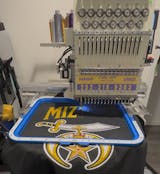1. Introduction to Machine Embroidery Learning
Machine embroidery is enjoying a resurgence because it fuses creativity with precision. From hobbyists to professional studios, structured learning helps you unlock your machine’s full potential and turn ideas into well-executed stitches.
This guide covers beginner resources, how to compare courses, essential tools, and strategies for advancing your skills—so you can grow from first stitches to polished projects on any embroidery sewing machine.
Table of Contents
- 1. Introduction to Machine Embroidery Learning
- 2. Beginner Machine Embroidery Classes for Foundational Skills
- 3. Top Institutions for Structured Machine Embroidery Courses
- 4. Essential Tools and Materials for Machine Embroidery Classes
- 5. Evaluating Machine Embroidery Classes: Costs and Outcomes
- 6. Creative Applications: From Learning to Professional Projects
- 7. Advanced Machine Embroidery: Bridging Skill Gaps
- 8. Conclusion: Building Your Embroidery Education Pathway
- 9. Machine Embroidery Class FAQ
2. Beginner Machine Embroidery Classes for Foundational Skills
Starting can feel intimidating, but the right class simplifies everything. Explore in-person workshops, flexible online courses, and the core competencies every beginner should master.
2.1 In-Person Workshops for Hands-On Learning
For tactile learners, in-person workshops deliver immediate feedback and real-world practice. Urban Spools’ two-part "Intro to Machine Embroidery" emphasizes stabilizer selection, hooping technique, and fabric-specific projects across cotton, stretch, and terry cloth. You’ll work on real embroidery machines with expert guidance and session-specific material kits. Beginners (15+) are welcome, and the hands-on format ensures you actively practice each step and leave with finished projects.
2.2 Self-Paced Online Course Options
Prefer flexibility? The School of Stitched Textiles’ "Machine Embroidery for Beginners" offers step-by-step video lessons, downloads, and projects such as greeting cards and drawstring bags, led by tutor Gail Cowley. Sewing Mastery’s "Machine Embroidery 101" and "Embroidery Essentials" provide over seven hours of video training on stabilizers, threads, needles, hooping, and design transfer, with lifetime access and brand-agnostic guidance—useful for any embroidery machine for beginners.
2.3 Core Skills Every Beginner Should Master
Guides from Maggie Frames and Tough Kitten Crafts highlight these fundamentals:
- Machine threading and understanding the thread path
- Needle selection (75/11 embroidery needles are a common start)
- Tension adjustment to avoid thread breaks and ensure clean stitches
- Stabilizer selection: tear-away, cut-away, or water-soluble based on fabric
- Test stitching on scrap fabric before the final piece
- Tool familiarity across machine, threads, stabilizers, and accessories
Pro tips include using cross-wound spools for smoother flow and joining online communities for brand-specific advice. Structured courses like Urban Spools or Sewing Mastery provide the most comprehensive foundation.
3. Top Institutions for Structured Machine Embroidery Courses
Leveling up often means formal training, expert guidance, and recognized certification. Choose accredited paths or specialized, hands-on training based on your goals.
3.1 Accredited Programs (SOFST & EGA)
SOFST’s City & Guilds-accredited Skill Stage 2 Machine Embroidery Course runs online for one to two years with modular learning that progresses from foundational to advanced techniques. You’ll learn from expert tutors within a creative community and develop skills through a personalized curriculum.
The Embroiderers’ Guild of America (EGA) offers correspondence courses, online studio classes, and virtual sessions for all levels. Their certified teachers emphasize technical mastery and creative exploration, with flexible pacing through correspondence formats.
3.2 Specialized In-Person Training
For immersive, hands-on instruction, Hand & Lock’s London workshops provide five-hour, one-on-one sessions tailored to your projects, including machine induction and a certificate. Quilter’s Corner hosts in-person and Zoom workshops on fabric selection, stabilizers, and project-based learning, often with machine-specific certification.
Both options support different goals: accredited programs deliver formal credentials, while specialized workshops emphasize immediate application and feedback.
4. Essential Tools and Materials for Machine Embroidery Classes
Success depends on both technique and the right setup. From machines and hoops to stabilizers and threads, gear choices shape your results and learning curve.
4.1 Machines and Hoops: Entry-Level to Professional
Two popular machines illustrate how gear affects your workflow:
- Brother PE800: Single-needle, beginner-friendly with a 5×7 inch hoop for small logos, patches, and starter projects.
- Brother Innov-is NQ1600E: Mid-tier model with 5×7 and 6×10 hoops, faster stitching, and automatic jump stitch cutting for larger designs and efficient production.
Hoop sizing considerations: Larger hoops (e.g., 6×10 or 5×12 multi-positional) enable bigger designs without rehooping, while smaller hoops excel at precision and tight spaces. Materials vary from plastic to wood; wooden hoops often provide superior tension for delicate fabrics. For practical selection and setup, explore embroidery machine hoops as you plan project sizes.
Introducing Sewtalent Magnetic Hoops: For garment embroidery and fast setup, Sewtalent magnetic embroidery hoops reduce manual adjustments with a powerful magnetic system that adapts to fabric thickness, delivers even tension, and prevents hoop burn.
Key advantages include:
- 90% Time Savings: Switching from a screw-based hoop to a Sewtalent magnetic hoop can cut hooping time from 3 minutes to about 30 seconds per garment.
- Reduced Defects: Consistent tension lowers misalignment and fabric waste, especially important at scale.
Sewtalent hoops work with most commercial machines and are available in over 17 sizes. Industrial-grade PPSU plastic and N50-grade magnets provide durability and strong grip—even on denim and towels. Looking to streamline setup? A magnetic hoop is a compelling upgrade over traditional screw-based options.
4.2 Threads, Stabilizers, and Fabric Selection
The right thread-stabilizer-fabric combo is essential for crisp, vibrant results.
Threads:
| Type | Fiber | Weight | Best For | Limitations |
|---|---|---|---|---|
| Rayon | Viscose | 30–40 | Decorative, shiny finishes | Fades with UV exposure |
| Polyester | Synthetic | 30–40 | Durable, frequent washing | Less soft than rayon |
| Cotton | Natural | 30–50 | Quilts, matte look, hand-embroidery | Lower tensile strength |
Stabilizers:
| Type | Use Case | Example |
|---|---|---|
| Tear-Away | Stable fabrics (cotton, linen) | Iron-On Tear-Away |
| Cut-Away | Stretchy fabrics (knits, fleece) | Fusible Polymesh |
| Self-Adhesive | Easy removal, minimal residue | Sticky Peel N Stick |
| Fusible | Appliqué backing, interfacing | Heat N Bond Lite |
Water-soluble toppings help dense stitching sit cleanly on the surface. Start practice on cotton, linen, or muslin; avoid delicate silks or loose weaves until you’ve dialed in stabilizers and tension. Always test on scrap before stitching the final piece. Small tools that matter: disappearing ink pens, chalk markers, embroidery snips, pinking shears, seam rippers, mini irons, and software like Embrilliance for editing and converting embroidery files.
5. Evaluating Machine Embroidery Classes: Costs and Outcomes
Not all classes are equal. Compare platforms by access model, curriculum depth, and measurable results.
5.1 Cost-Benefit Analysis of Learning Platforms
- Udemy: Free "Introduction to Freehand Machine Embroidery" (21 lessons, 1h 2m) covering freehand stitching, sewing-machine basics, and classic needlecraft—ideal for newcomers sampling the basics.
- Teachable: Paid "Machine Embroidery 101" and "Embroidery Essentials" with lifetime access. Expect deep coverage of stabilizers, threads, needles, hooping, multi-material projects, and troubleshooting—great for building practical, brand-agnostic mastery.
- Skillshare: Subscription-based "Hand Embroidery 101" (4h 11m) focuses on hand embroidery and is less relevant for machine-focused learners.
Which to choose? Start with Udemy if you need a free intro. For structured, hands-on training and lasting reference, Teachable’s courses provide the strongest value.
5.2 Measuring Skill Development Effectiveness
- Originality scores: Structured machine embroidery courses reached 84% originality in RBL study data.
- Course ratings: NYC-based classes average 4.6/5, reflecting instructor quality and relevant curricula.
- Time-to-proficiency: Many beginners reach core competency in 3–6 hours of focused instruction.
Pick courses with strong ratings, proven outcomes, lifetime access, and hands-on projects to maximize skill growth and return on investment.
6. Creative Applications: From Learning to Professional Projects
Training turns into creative output across apparel and home décor—and can scale into commercial work.
6.1 Apparel Customization Techniques
- Monograms and logos: Beginner-friendly projects with modest stitch counts and strong visual impact.
- Branded uniforms and promotional gear: Durable, professional embroidery on towels, shirts, and bags.
- Luxury embellishments: Intricate patterns and reflective finishes for high-end appeal, with strong demand.
Stitch optimization: Techniques like fill-to-satin conversion can reduce stitch counts by up to 75%. Appliqué integration, underlay optimization, and color grouping further streamline production without sacrificing quality.
6.2 Home Décor and Commercial Opportunities
- Table linens, curtains, and wall hangings: Embroidered décor elevates everyday items.
- Personalized gifts: Tote bags, pillows, and seasonal accessories benefit from quick, low-stitch designs.
Bulk production techniques: Consistency is critical at volume. Tools such as magnetic hoops for embroidery machines offer even tension and rapid setup—ideal for large runs without sacrificing quality.
7. Advanced Machine Embroidery: Bridging Skill Gaps
As the industry expands, advanced training in operation, maintenance, and digitization becomes essential to move from basics to mastery.
7.1 Specialized Operation and Digitization Courses
Standard curricula often underemphasize hands-on troubleshooting and maintenance. Practical modules should cover diagnosing tension issues, replacing needles, stabilizer selection by fabric, and routine calibration. On the software side, advanced training should go beyond basics into efficient stitch planning, color management, file optimization, and the role of AI-assisted design and cloud collaboration.
Recommended curriculum elements:
- Troubleshooting workshops (thread breaks, puckering, alignment)
- Machine maintenance modules (calibration, needles, fabric-specific stabilizing)
- Deep dives into digitizing software (Hatch, InkStitch, Wilcom) and emerging tools
- Industrial workflow insights (scheduling, bulk production, quality control)
7.2 Resources for Multi-Needle Machine Mastery
Multi-needle systems rely on threading sensors and smart bobbin management to minimize downtime. Yet hands-on training for these features is scarce. Courses should also address copyright, licensing, and trademarks, plus industrial workflow optimization (e.g., productivity improvements through better scheduling and quality control).
When scaling, consistent hooping and mounting methods matter as much as software. Incorporating proven hardware approaches—such as magnetic hoops for embroidery—can support repeatable quality alongside advanced digitizing and maintenance skills.
8. Conclusion: Building Your Embroidery Education Pathway
Choosing your path means balancing embroidery machine prices, skill goals, and budget. Beginners thrive in hands-on, foundational courses like "Embroidery Essentials," while advanced learners benefit from digitization and industrial workflow modules. Keep learning, keep practicing, and let each project move you closer to mastery.
9. Machine Embroidery Class FAQ
9.1 Q: What are the prerequisites for machine embroidery classes?
A: Most beginner classes require no prior experience. You’ll need access to a basic embroidery machine, a hoop, threads, stabilizers, and fabric. Some advanced courses recommend familiarity with basic operation or introductory software skills.
9.2 Q: What types of practice projects are common in classes?
A: Typical projects include monograms, simple motifs, greeting cards, drawstring bags, and small home décor. These reinforce hooping, thread selection, and design transfer while building confidence.
9.3 Q: Where can I find troubleshooting resources for common embroidery issues?
A: Many online platforms provide guides on thread breaks, puckering, and alignment. Manufacturers and software providers also offer forums, tutorials, and manuals for resolving technical challenges.
9.4 Q: How can I choose the right class for my skill level?
A: Assess your experience, learning style, and goals. Beginners benefit from structured, hands-on classes with guided projects; advanced users should seek digitization, multi-needle workflow, and industrial process modules. Reviews and course descriptions help you find the best fit.
9.5 Q: Are there online communities for machine embroidery learners?
A: Yes—discussion forums, groups, and community boards connect students and instructors for tips, project ideas, and troubleshooting support.




